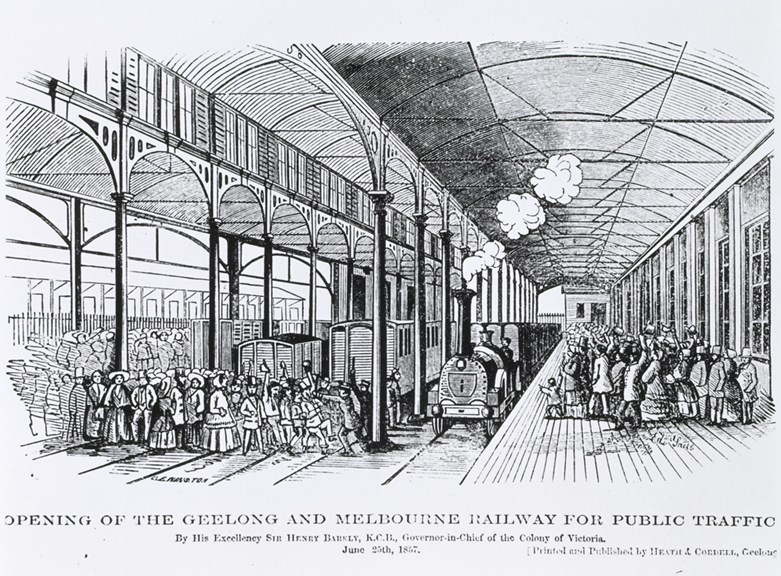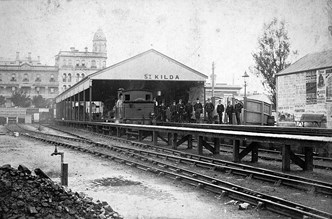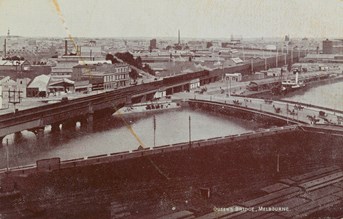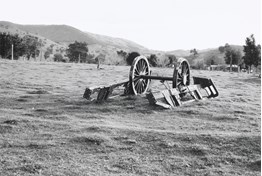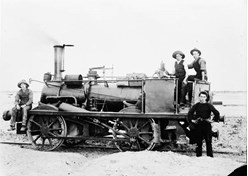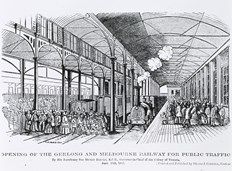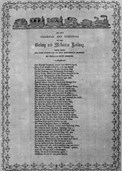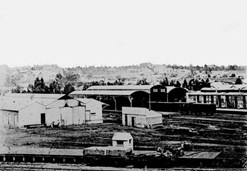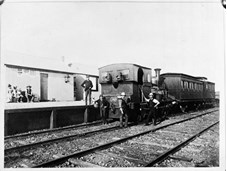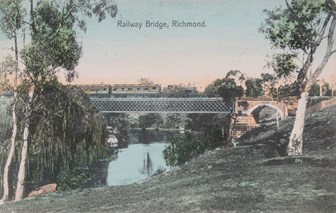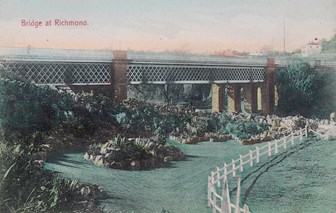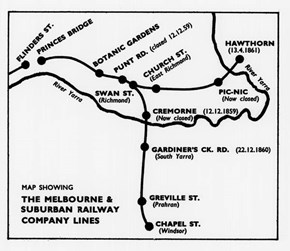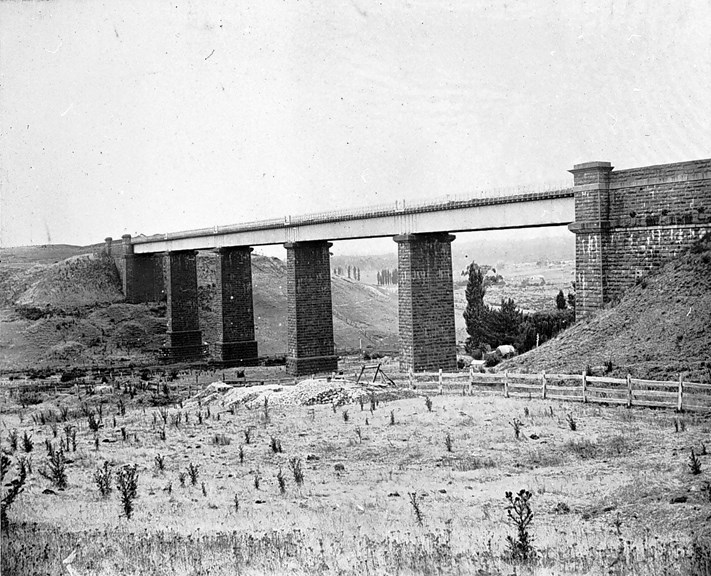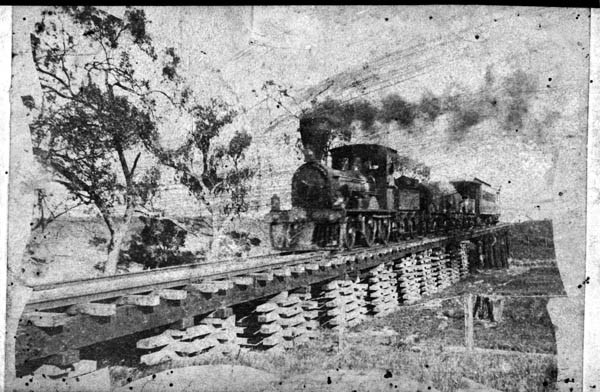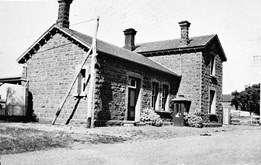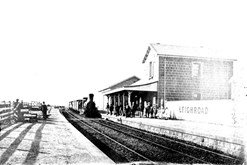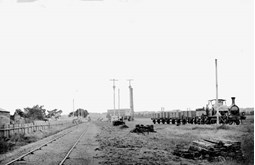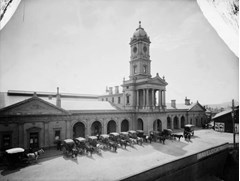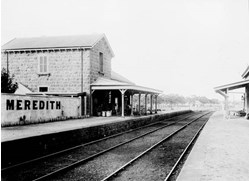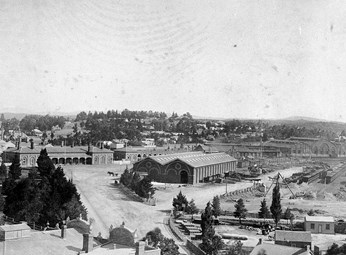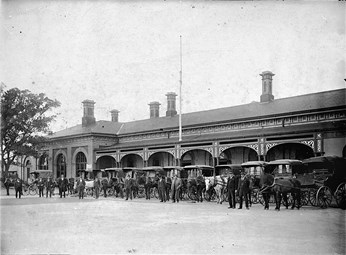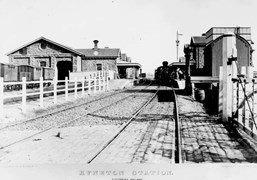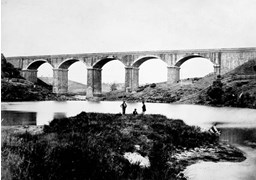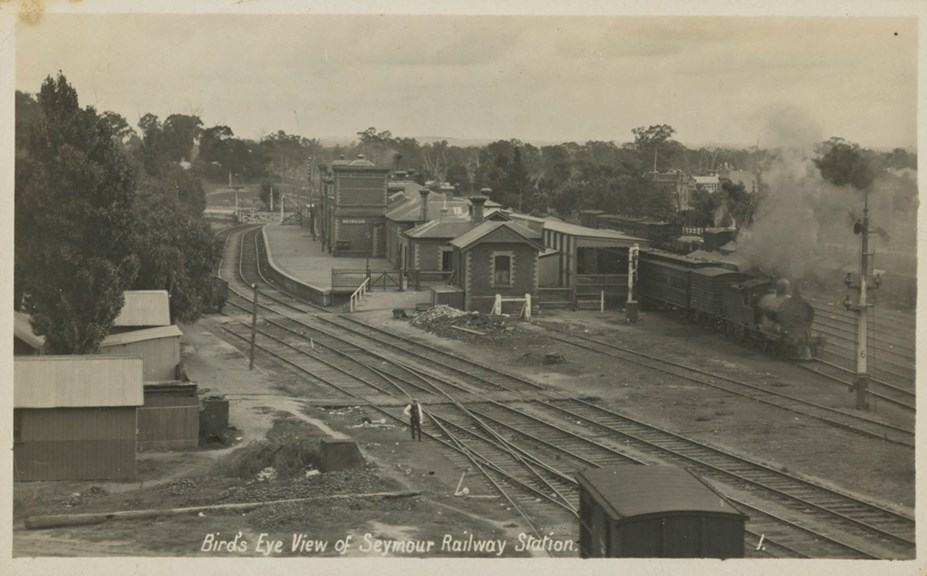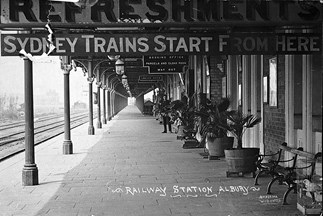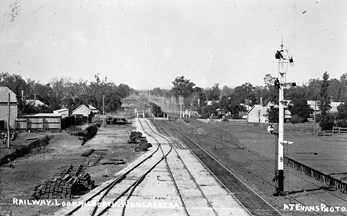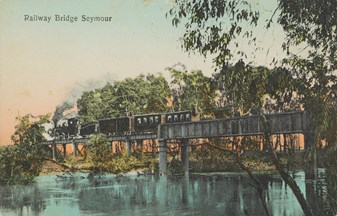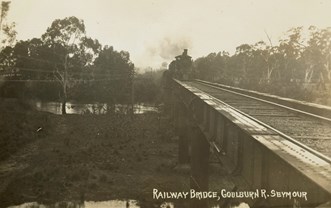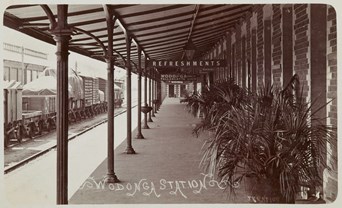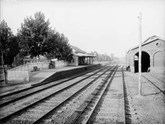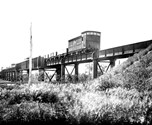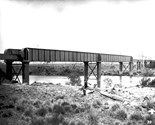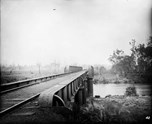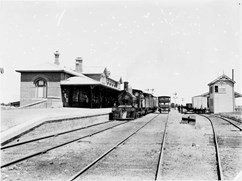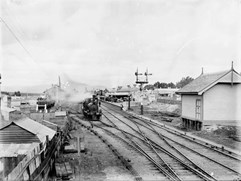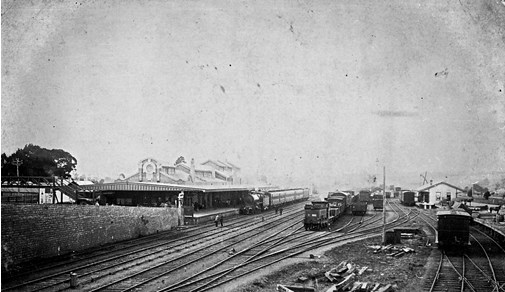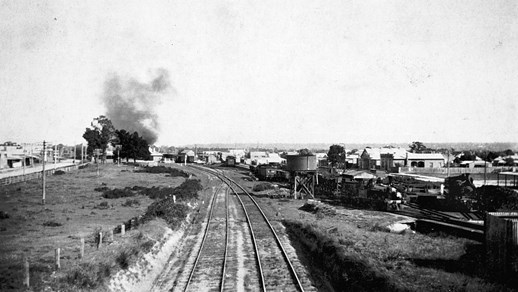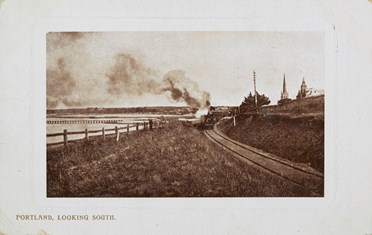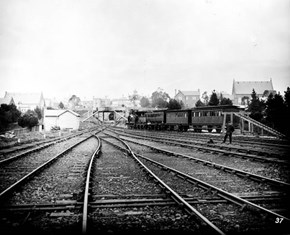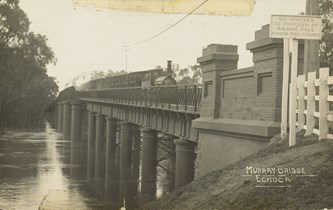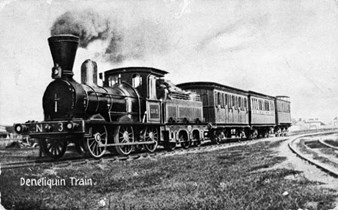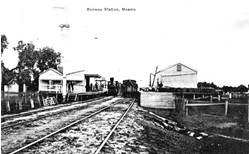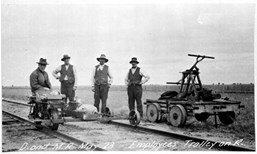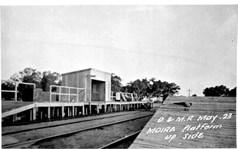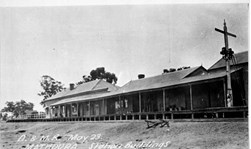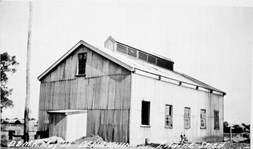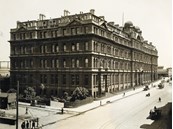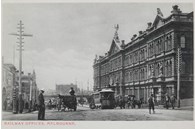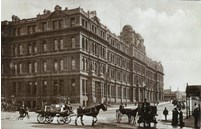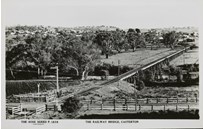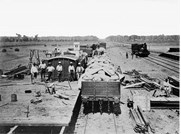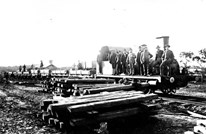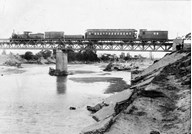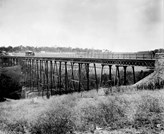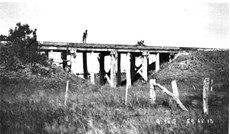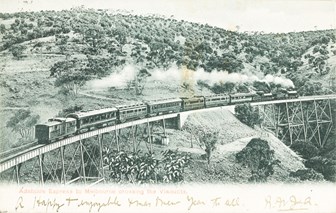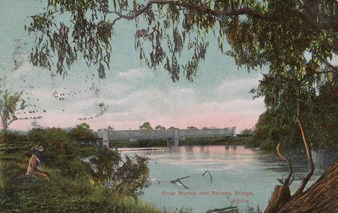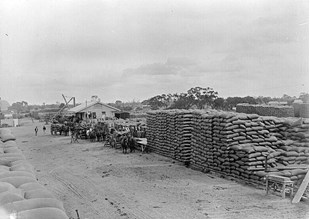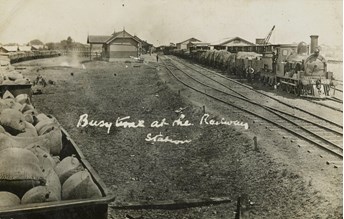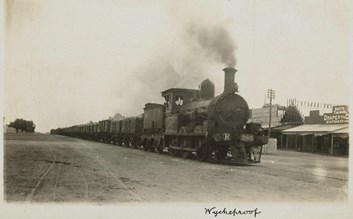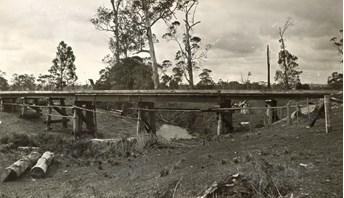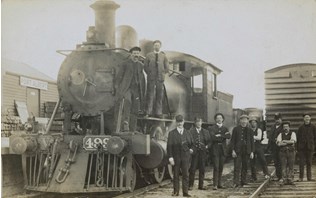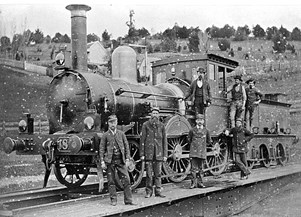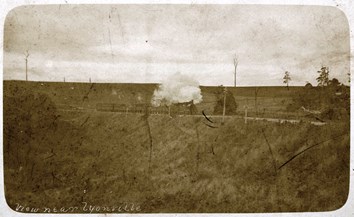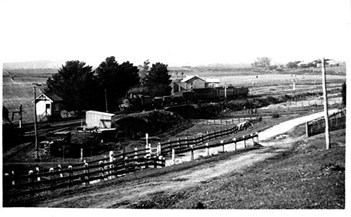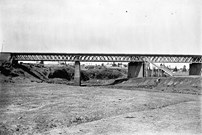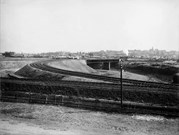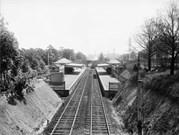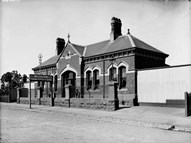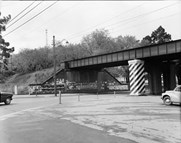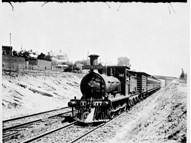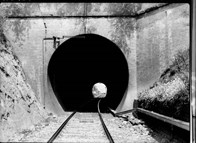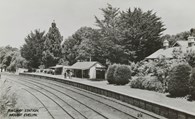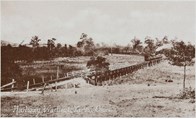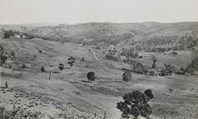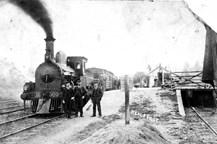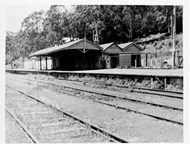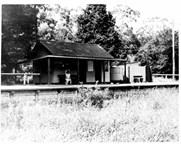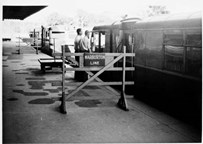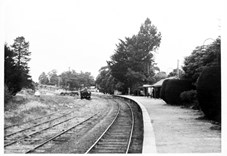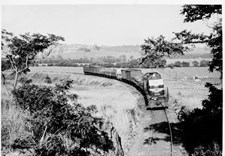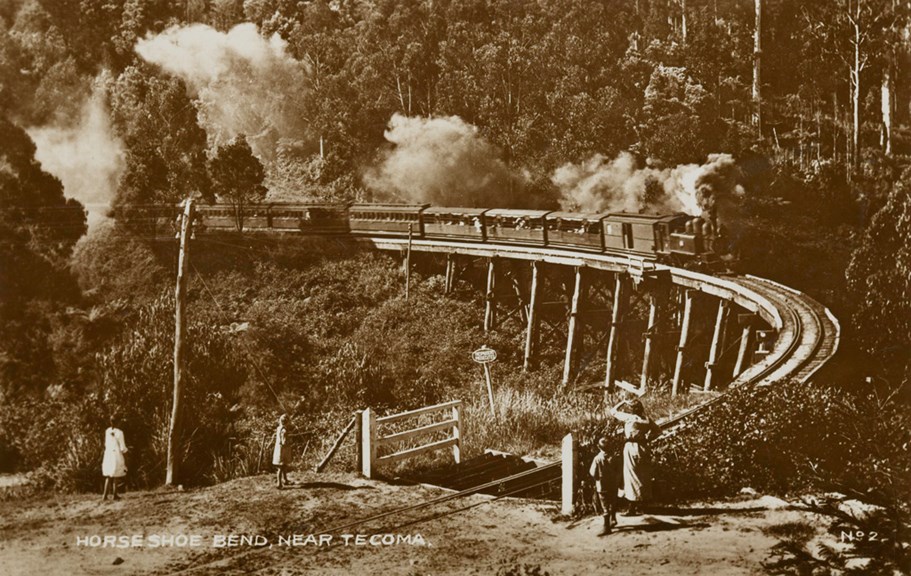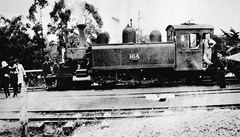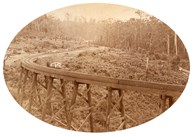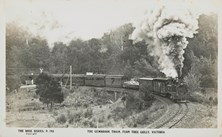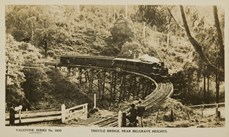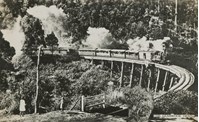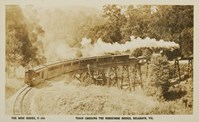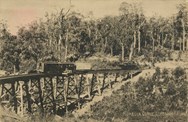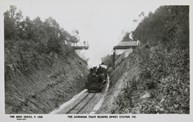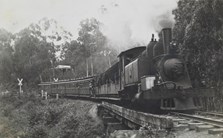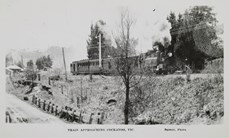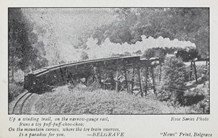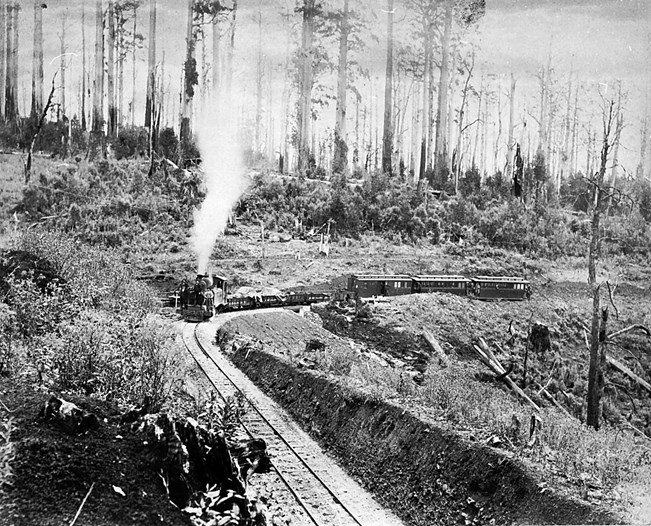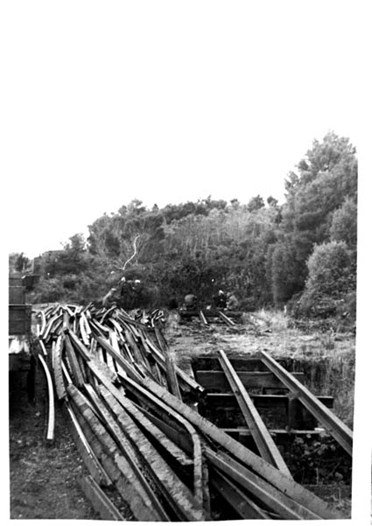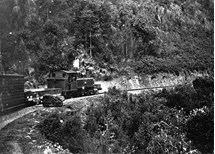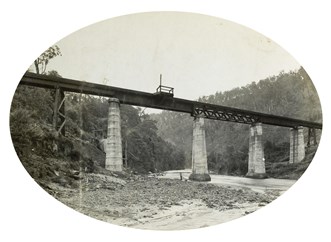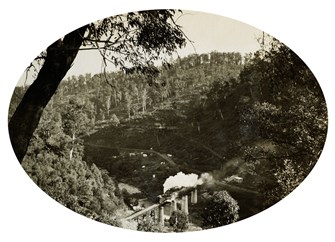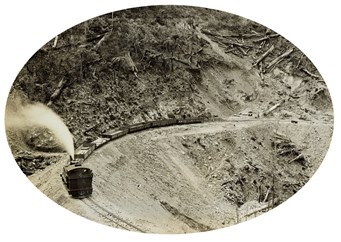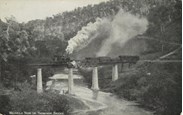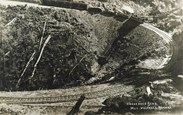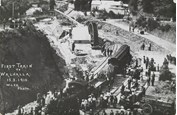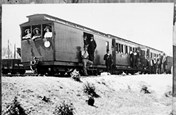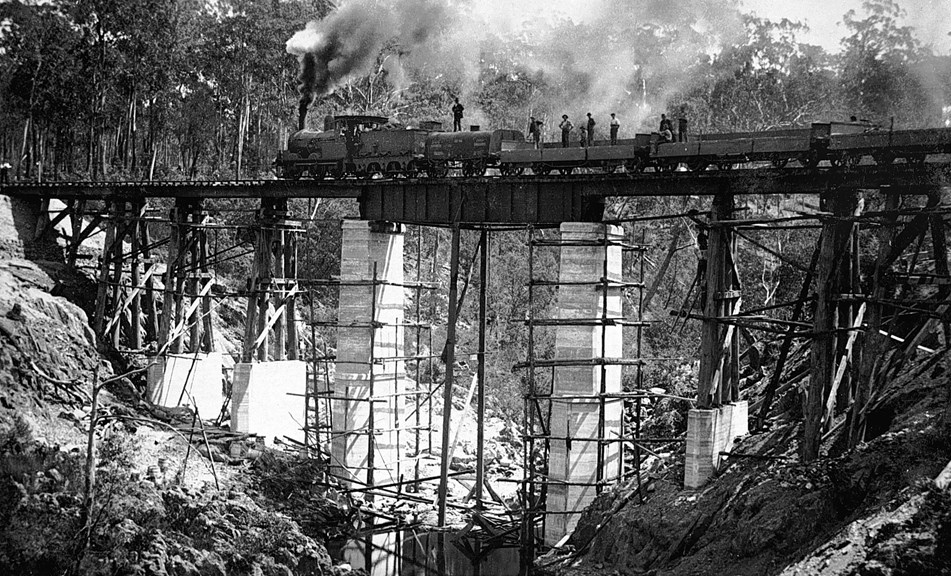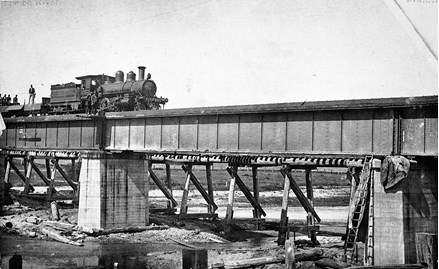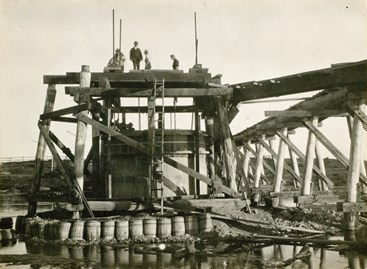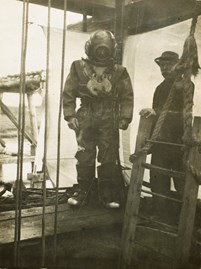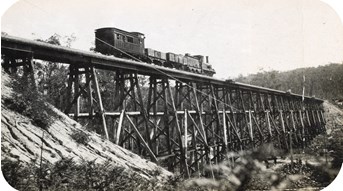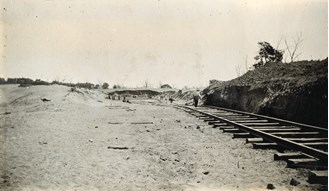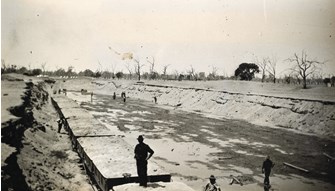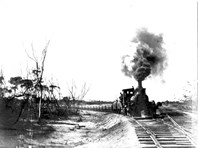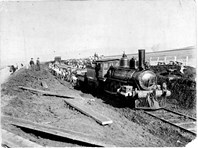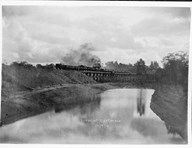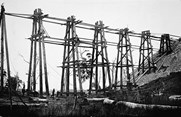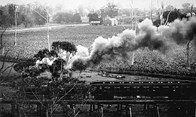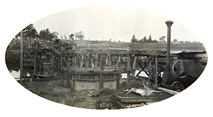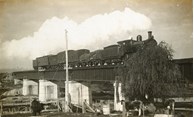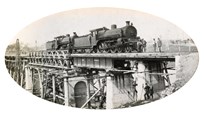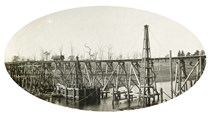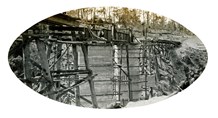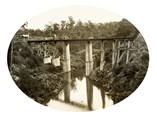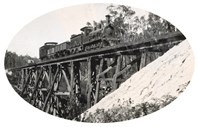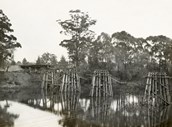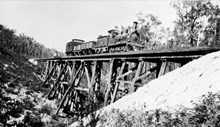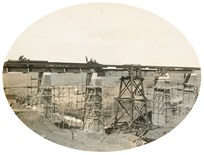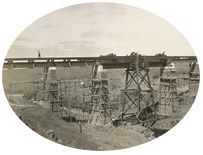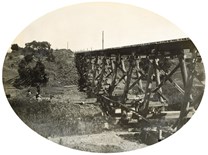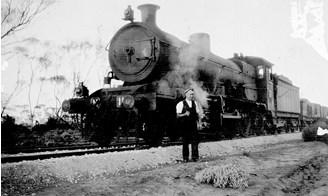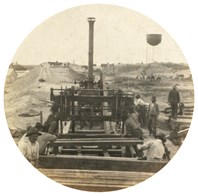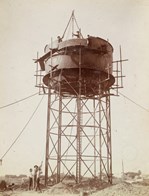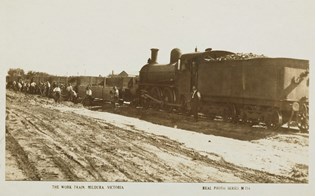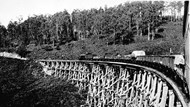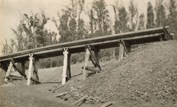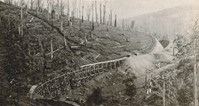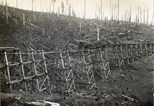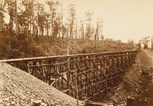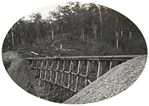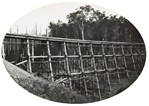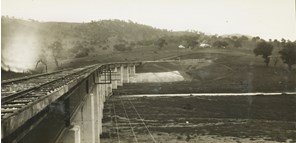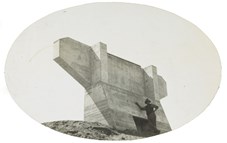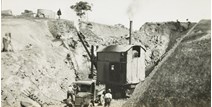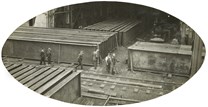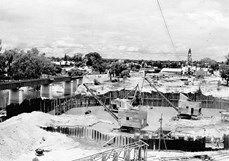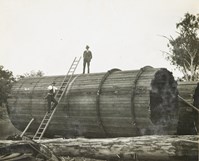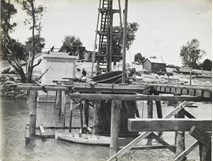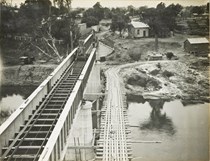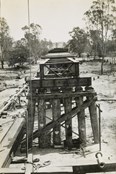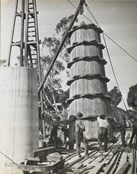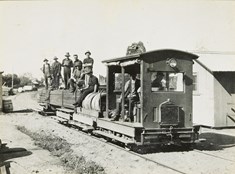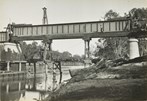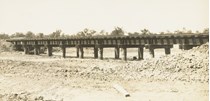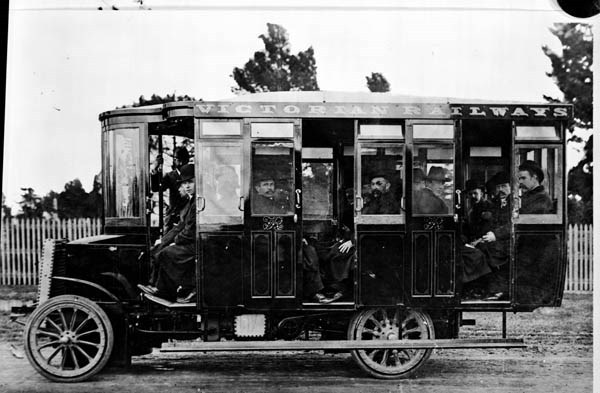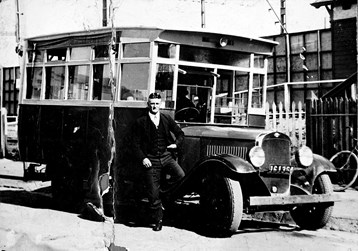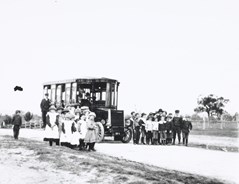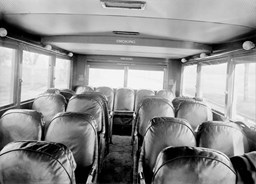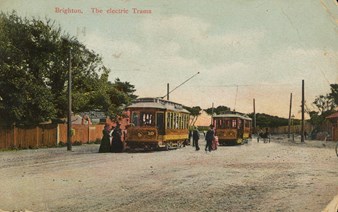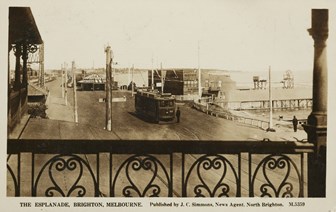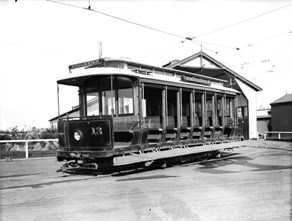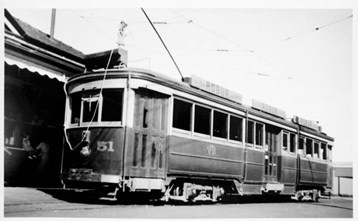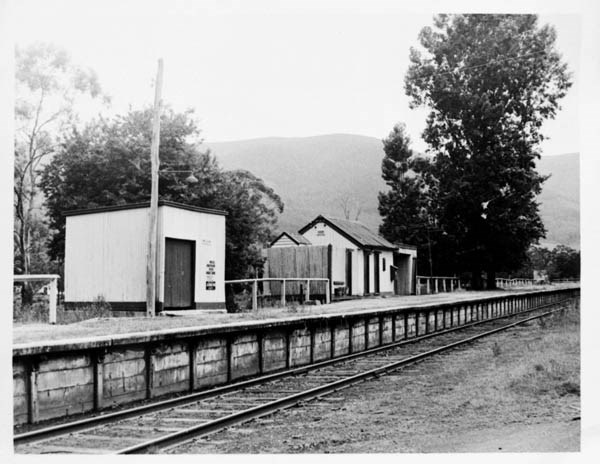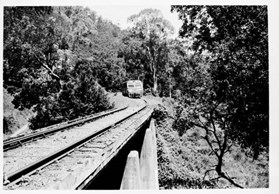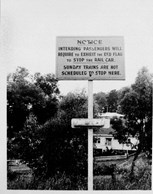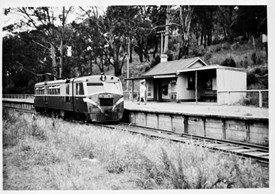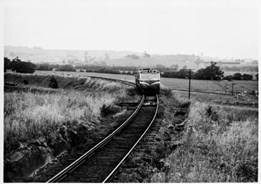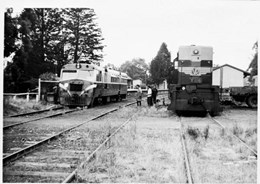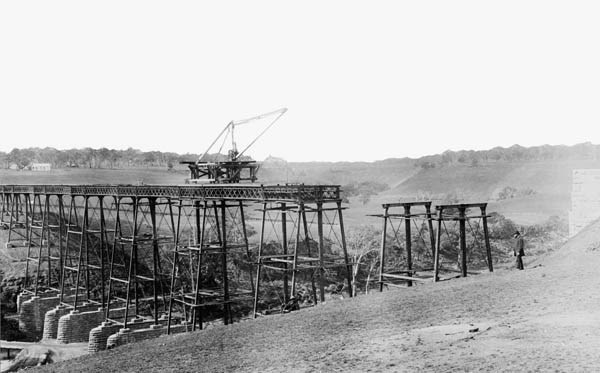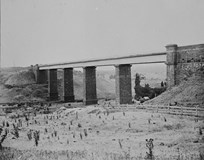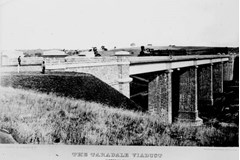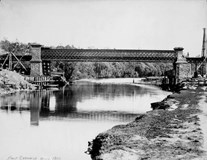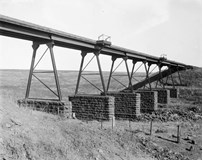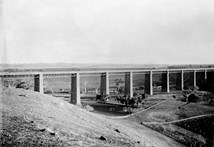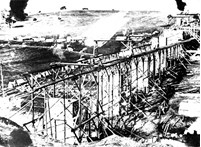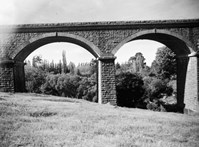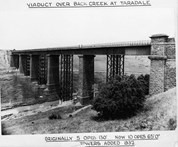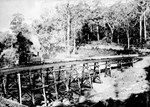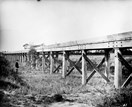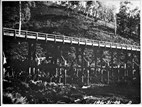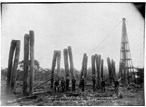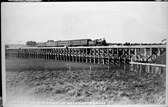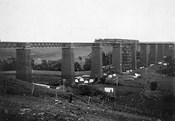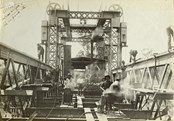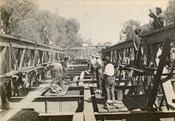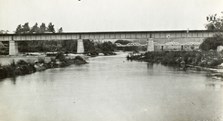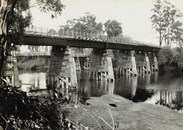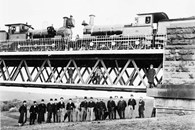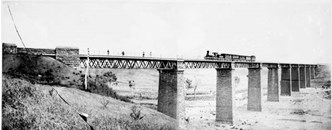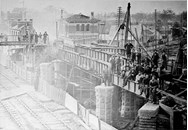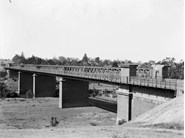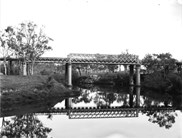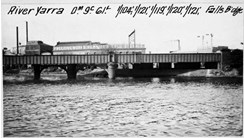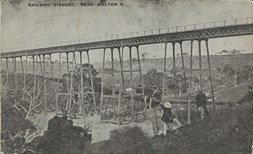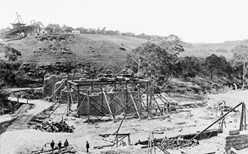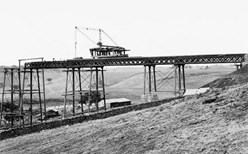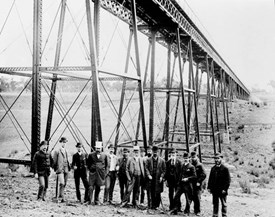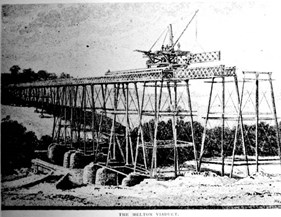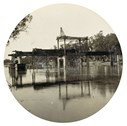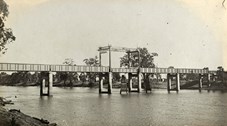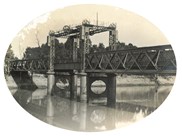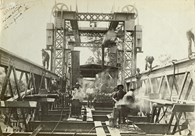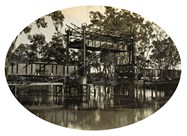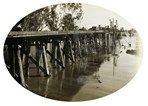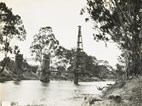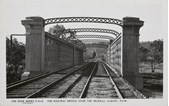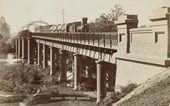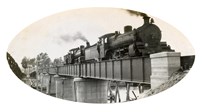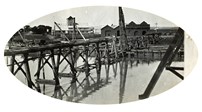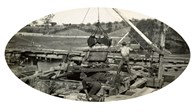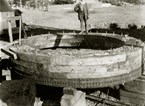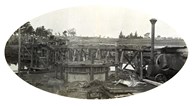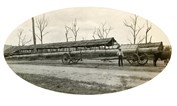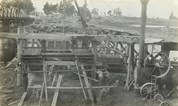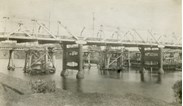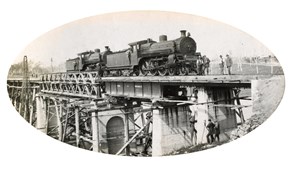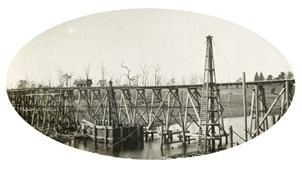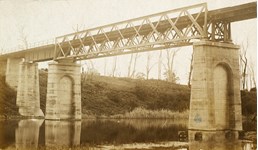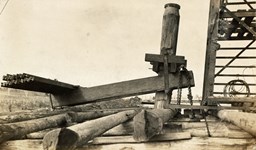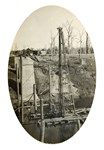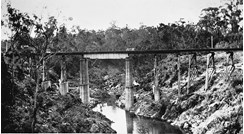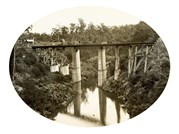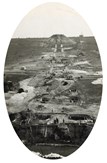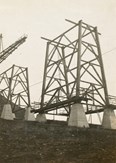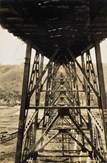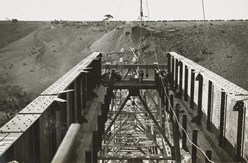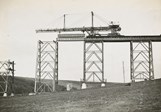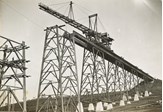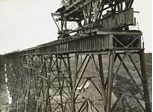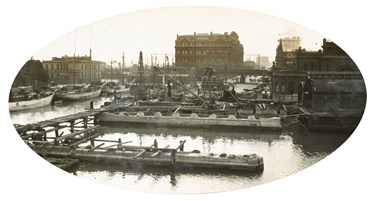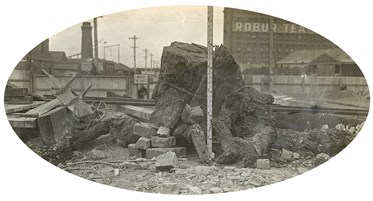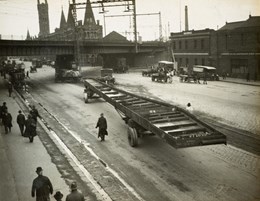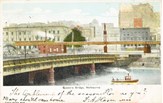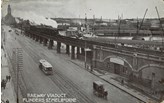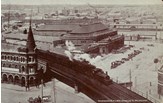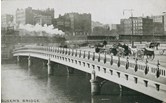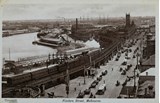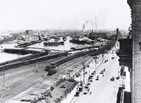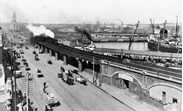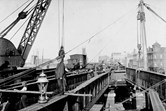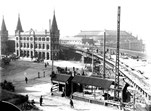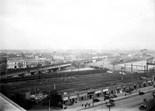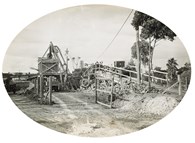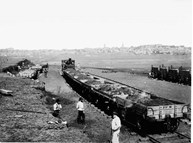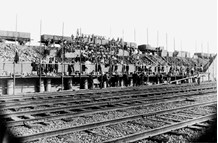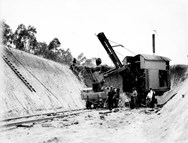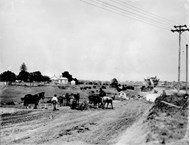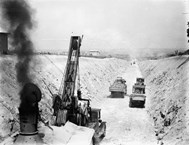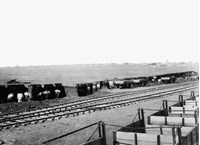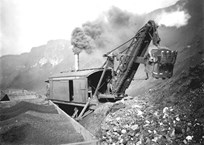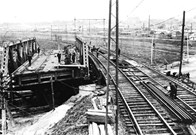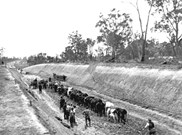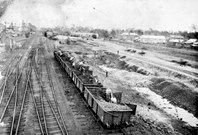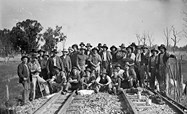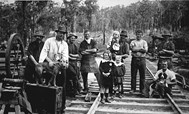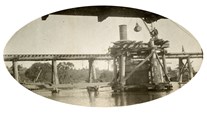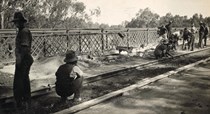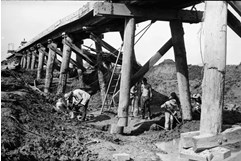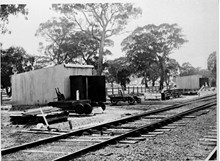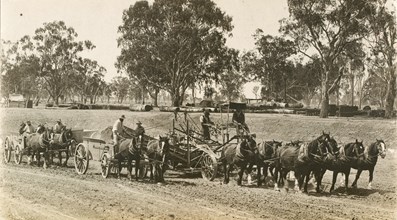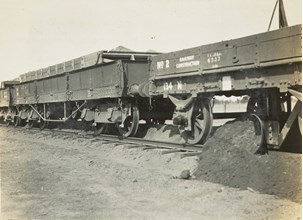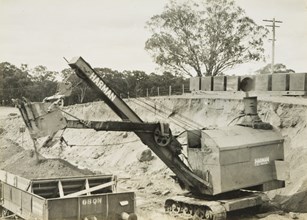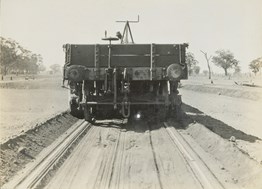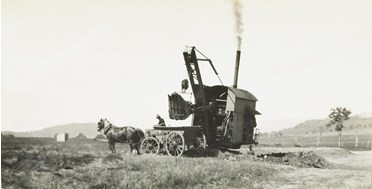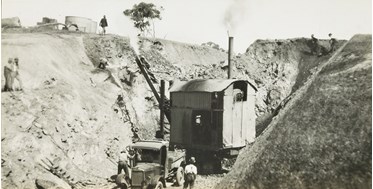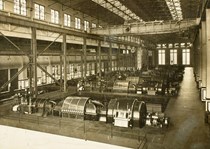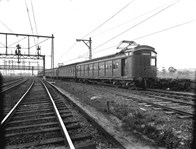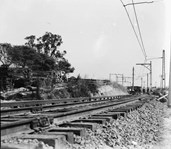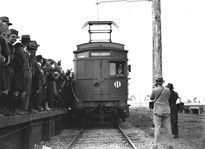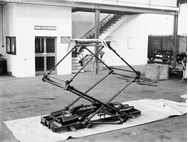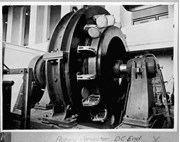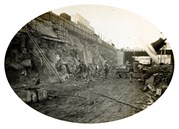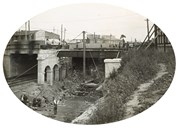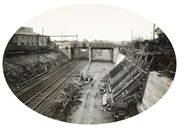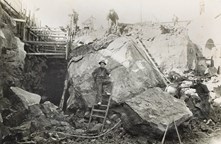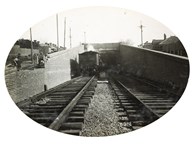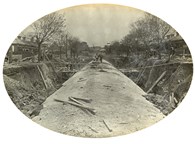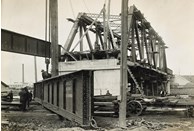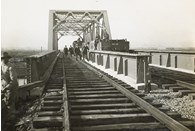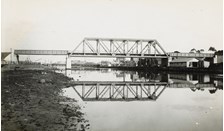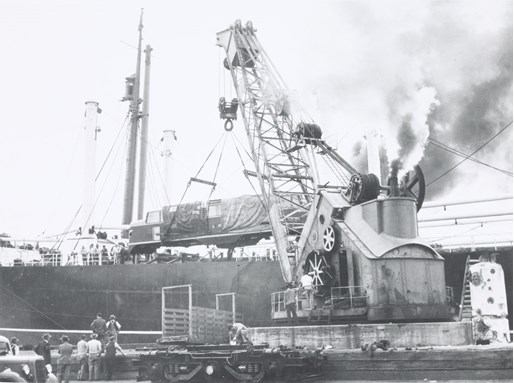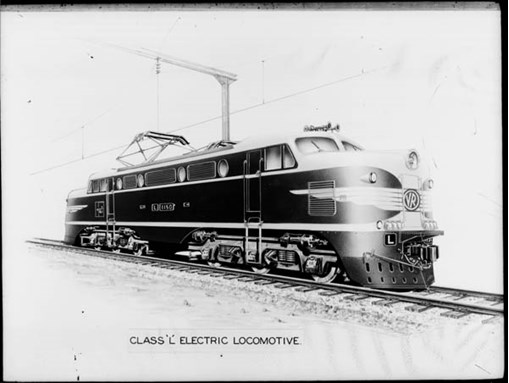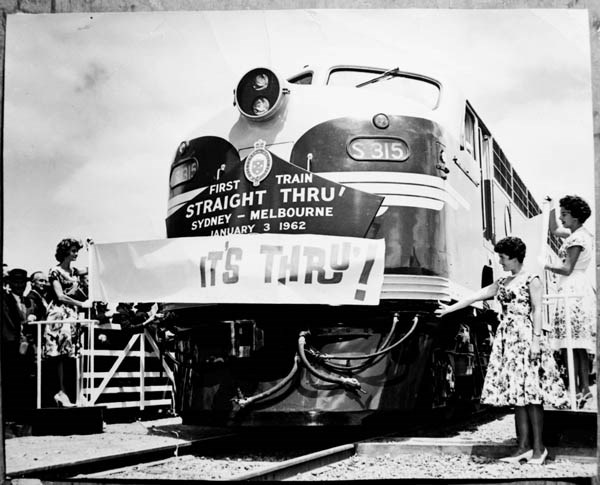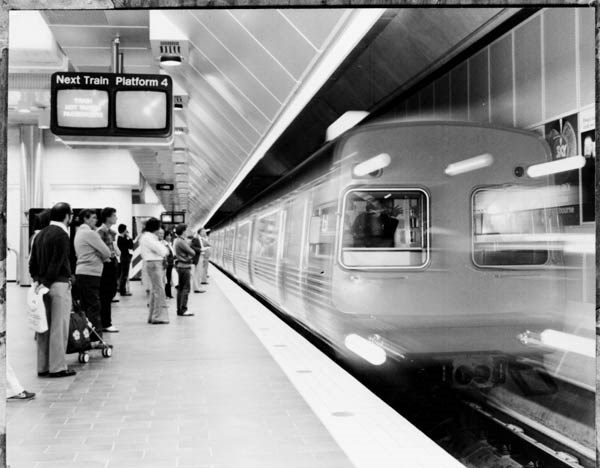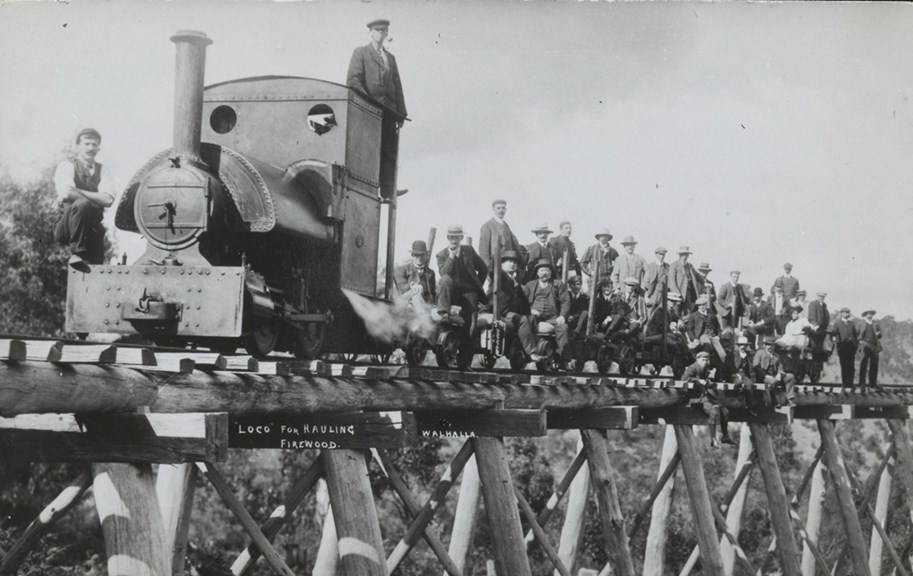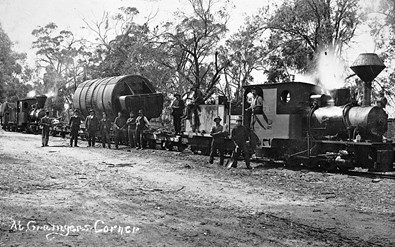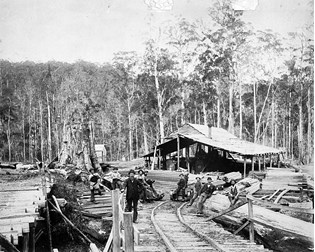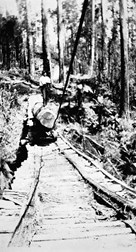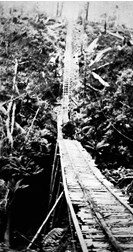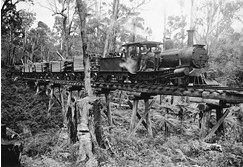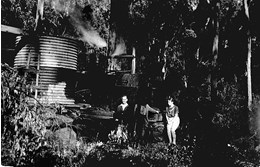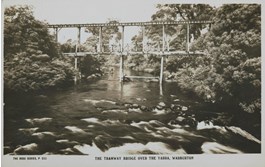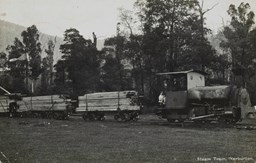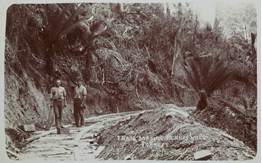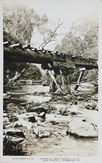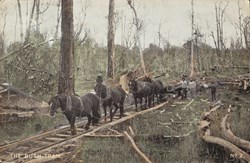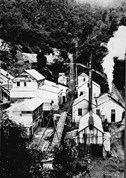Making tracks
The construction of Victoria's railway system has required one of the State's largest and most sustained investments in public infrastructure. Flushed with the tremendous wealth generated by the goldfields, the Victorian government invested £9 million over the first decade of railway development between 1854 and 1864 to build just 254 miles (409 km) of railway, while private railway companies invested another £1.8 million. Over the next sixty years the railway system continued to expand rapidly reaching 2,900 route miles (4,670 km) by 1891 and 4,700 miles (7,565 km) in 1931, representing a total investment of almost £50 million. By this time, every town in Victoria with a population of over 500 boasted its own railway station.
Railways provided the infrastructure that linked rural communities and enabled the early suburban expansion of metropolitan Melbourne. The long boom in Victorian railway development is characterised by five distinct periods: the private railway company era (1854-1865), birth of the government railways (1856-1864), the trunk lines and 'light' lines era (1871-1879), the Octopus Acts era (1880-1891) and the Construction Branch era (1892-1939). Since the Second World War, the system has gradually contracted as rationalisations led to the closure of poorly patronised and non-paying branch lines, but major new investments have also occurred, most notably the construction of standard gauge links to Sydney and Adelaide and the construction of the Melbourne underground loops.
Railway company mania
Early railway development in Victoria began in the gold rush era of the early 1850s, when the colony was flush with new found wealth and the population of Melbourne and major inland centres was rapidly expanding.
Within three months of the first gold discoveries in 1851, a public meeting was called in Melbourne to discuss a proposal to build a railway from the beach at Sandridge (now Port Melbourne) to the city. Within two years no less than eight private companies were being promoted with plans to build over 500 miles (800 km) of railways in Melbourne and beyond.
In February 1853, three of the private railway proposals gained parliamentary consent and substantial crown land grants: the Melbourne & Hobsons Bay Railway, the Geelong & Melbourne Railway and the Melbourne, Mount Alexander & Murray River Railway. Raising sufficient funds to build the railways proved more difficult in period of high inflation and acute labour shortages. Only two of the railways were completed without direct government assistance and only one ever made a profit.
Between 1857 and 1861, further private companies gained approval to build railways to Hawthorn, Brighton and Essendon, but the high cost of construction and poor patronage forced all into liquidation. By 1865, the remaining private companies had merged to form the Melbourne & Hobsons Bay United Railway Company. It would be ten years before the government began negotiations to acquire the remaining private railway assets but the era of private railway development was all but over.
Melbourne & Hobsons Bay Railway Co
The Melbourne & Hobsons Bay Railway Company opened Australia's first steam railway when public services began on 12 September 1854 on its short 2¼-mile (3.6 km) line connecting Melbourne with a deepwater pier at Sandridge (later Port Melbourne) on Hobsons Bay.
Despite high construction costs the railway was an immediate success carrying 270,000 passengers and 28,135 tons of goods in its first full year of operations. In 1857 the company opened a second railway to St Kilda and in 1865 merged with the remaining suburban railway companies to form the Melbourne & Hobsons Bay United Railway Company.
Geelong & Melbourne Railway Co
Victoria's first country railway was built by the Geelong & Melbourne Railway Company. Funded largely by British shareholders, construction commenced from the Geelong end in 1854 but made slow progress due to labour shortages caused by the goldrushes. The 38½-mile (62 km) line finally opened with gala celebrations on 25 June 1857.
Because the line terminated at Greenwich (near Newport), passengers were initially obliged to transfer to a steamer at Williamstown for connection to Melbourne or the Sandridge Railway Pier. This situation was finally relieved with the opening of the Williamstown Railway in January 1859, but the Geelong Railway continued to operate at a loss and sold out to the government for £800,000 in June 1860.
Melbourne & Suburban Railway Co
The Melbourne & Suburban Railway Company was formed in June 1857, with plans to build railways from a terminus at Princes Bridge to Hawthorn and Brighton, on the outskirts of Melbourne's urban fringe. Construction commenced in July 1858 but was hampered by a lack of capital, due partly to the high cost of building two substantial iron bridges over the Yarra River at Cremorne and Hawthorn.
Their first line to Windsor opened in December 1860, followed by the Hawthorn line in April 1861. Although revenue exceeded working expenses, the company was unable to repay debts incurred during construction and in March 1862 its assets were sold to the Melbourne Railway Co for just £47,500 – one-tenth of the original cost.
Birth of the government railways
Direct government involvement in the construction and operation of Victoria's railways came about almost by default with the failure of the Melbourne, Mount Alexander & Murray River Railway Company and other early private railway enterprises.
The parliamentary Act authorising formation of the Victorian Railways Department was passed on 19 March 1856 with £125,085 being paid for the partially completed construction work on the Williamstown line undertaken by the Mount Alexander Co. G.C. Darbyshire was appointed shortly afterwards as Engineer-in-Chief and by November 1856 contracts had been let for the major construction works on the lines to Williamstown and Bendigo. The first official Government train services commenced on 13 January 1859 running from the Spencer Street terminus in Melbourne to Williamstown and Sunbury on the Bendigo line.
Meanwhile, the Government had purchased the Geelong & Melbourne Railway in 1860 and commenced construction of a line from Geelong to Ballarat to complete the railway links with Victoria's key mining centres. The initial period of government railway development in Victoria concluded with the opening of an extension of the Bendigo line to Echuca on the Murray River in 1864. There was to be a seven year lull before railway expansion resumed.
Government railway construction during this early period was characterised by extravagant expenditure on works designed to the best British mainline standards incorporating evenly graded double track lines with substantial earthworks, grand bridges built of iron, stone and brick and solid bluestone station buildings.
Geelong to Ballarat Railway
Evans, Merry & Company were awarded the construction contract for the Geelong to Ballarat Railway for £1,271,841 with the works inaugurated by an elaborate ceremony at Geelong on 26 August 1858. The 54-mile (87 km) line featured substantial engineering works with seven finely executed bluestone arch bridges and the impressive ten-span Moorabool Viaduct.
The line opened to passengers on 10 April 1862 and goods traffic the following August. Until the final link in the more direct Sunshine-Ballarat line was completed in 1889, it remained the main railway route from Melbourne to Ballarat and beyond.
Mount Alexander & Murray River Railway
The Melbourne, Mount Alexander & Murray River Railway Company received parliamentary assent in February 1853 to build Victoria's first inland railway from Melbourne to Williamstown, Bendigo and Echuca. Construction commenced in January 1854 with work on a pier at Williamstown but lack of funds slowed progress, eventually prompting the company to sell out to the government.
The 100-mile (162 km) section to Bendigo opened in October 1862. Its cost of £35,000 per mile made it the most expensive railway ever built in Australia. In 1864, the line was extended to Echuca, tapping into the booming Murray-Darling paddlesteamer trade.
Trunk routes and light lines
Following the extravagant expenditure on the construction of the Victorian Government's first inland railways, it was to be almost a decade before railway expansion resumed.
The next phase of railway development, lasting throughout the 1870s, saw the completion of additional trunk routes or main lines from Essendon to Wodonga, from Oakleigh to Sale and westward from Ballarat to Ararat and Horsham (on a route that would later extend to Adelaide). Intense political lobbying from pastoral interests led to an inquiry that investigated the various merits, projected costs and revenue of four alternative rail routes to serve south-western Victoria. Ultimately it was decided to extend a line westwards from Geelong to Colac (which later reached Warrnambool and Port Fairy) and to build a separate line from Ararat to Portland through Hamilton. In central Victoria the first branchlines were built to places such as Maryborough, Dunolly, St Arnaud and Inglewood to serve rapidly developing farming and mining districts.
Under public criticism over the cost of earlier railway construction, the Railways Department investigated various models for cheaper construction, including the possible use of narrow gauge lines and the methods successfully adopted by the new frontier railways in America. The result was an era of 'light lines', in which average construction costs were reduced to just £5,000 per mile (less than a sixth of that for the Bendigo and Ballarat lines), through the use of lighter rails, single track formations with reduced ballast, limited earthworks, cheaper iron and timber bridges without expensive masonry abutments or piers and more modest station buildings. New lighter locomotives were ordered from the Phoenix Foundry to operate goods and passenger services on the light branch lines at a reduced speed of just 24 km/hour compared to the 64 km/hour allowed on mainlines.
North-East Railway
Construction of the North-East Railway to Wodonga commenced in 1870 and was completed in November 1873. The line incorporated three substantial iron bridges over the river and floodplains at Seymour, Benalla and Wangaratta and was initially built as a single track only.
It would be another decade before New South Wales completed the line from Sydney to Albury and a connecting rail bridge was built over the Murray River, but passengers and goods were still forced to change trains at Wodonga and Albury due to the break of gauge.
Western trunk lines
Gippsland Railway
Light branch lines
Moama to Deniliquin Railway
The Octopus Act lines
The decade of the 1880s was to produce the most frenzied period of railway expansion in Victoria's history, fuelled by a boom in urban land speculation and rapid agricultural development in the Wimmera, north-east and Gippsland.
Two Acts of Parliament passed in December 1880 and December 1884, authorised the construction of 23 and 66 new lines respectively, more than doubling Victoria's railway network to a total of 2,903 route miles (4,672 km) by 1892. They would become famously known as the "Octopus Acts" in reference to the tentacle like web of tracks created. The period was characterised by blatant political interference in railway planning with parliamentarians shamelessly lobbying to have railways built through their own electorates or even to serve land developments in which they had a direct financial interest.
The expansion included much of the northern, eastern and south-eastern Melbourne suburban system reaching largely to its current extent today, far beyond the likely growth of suburban development in the late 19th century. Country lines were extended from the existing mainlines to reach every part of the colony except the far north-west and north-east corners. Short spur lines that would never pay were built to many smaller towns bypassed by earlier railways, while towns like Heathcote, Maffra, Avoca and Daylesford even gained two railway lines approaching from either direction.
The epitome of the era's excesses was probably the Outer Circle Railway from Fairfield to Oakleigh, completed in March 1891. Originally envisaged as means of connecting the isolated Gippsland line to the government's western and northern railways, its purpose became redundant when the government purchased the Melbourne & Hobsons Bay United Railway Company in 1878 and subsequently completed a viaduct connecting Flinders Street and Spencer Street Stations in 1892. For decades the Outer Circle Railway lay beyond the boundary of urban growth and never carried a through service along its entire length.
Intercolonial connections
The wheat lines
Great Southern Railway
Mountain branch lines
To northern suburbs
Yarra Valley branch lines
Narrow gauge fad
Ferntree Gully to Gembrook Railway
The 18.25 mile (29.2 km) narrow gauge railway from Upper Ferntree Gully to Gembrook opened on 18 December 1900. Serving mainly local farming communities, sawmillers at Gembrook, and of course tourists, the line remained in operation until closed by a landslip in April 1954. After interest from railway enthusiasts the line was temporary reopened from Upper Ferntree Gully to Belgrave from December 1954 to February 1958. After this the section was closed for conversion to broad gauge, reopening on 18 February 1962 with suburban electric trains running as far as Belgrave. Subsequently, the narrow gauge track beyond Belgrave was reopened as a steam-operated tourist railway to Menzies Creek (in 1962), Emerald (in 1965), Lakeside (in 1975) and finally to Gembrook (in 2000).
Colac to Beech Forest and Crowes Railway
The 29.75 mile (47.6 km) narrow gauge line from Colac to Beech Forest opened on 1 March 1902, later being extended 14.11 miles (22.6 km) to Crowes on 20 November 1911. It was the busiest of all the Victorian Railways narrow gauge railways, carrying mainly timber traffic from sawmills in the Otway Ranges and serving some small farming communities. The line beyond Weeaproinah closed in December 1954, but the remaining section from Colac to Beech Forest and Weeaproinah remained in operation until June 1962, making it the last government narrow gauge line in Victoria to close to regular traffic.
Moe to Walhalla Railway
The 22 mile (35.2 km) railway from Moe to Walhalla was the last Victorian Railways narrow gauge line to be completed, opening on 3 May 1910. Ironically, the last of Walhalla's major gold mines closed the following year. A mass exodus of the towns population saw many miners using the railway to move their small wooden cottages. Traffic in later years was fairly sparse, despite the development in the 1920s of a the Government sponsored Baw Baw walking trial from Warburton to Walhalla in an attempt to promote tourism. The line beyond Platina closed in April 1944 and the Erica to Platina section in 1952. The remaining section closed in June 1954 following the decline of sawmilling in Erica and in the Tyers Valley.
Construction branch era
Following the extravagance of the 'Octopus Act Era', the responsibility for constructing of new railway lines in Victoria was transferred in 1892 from the Victorian Railway Commissioners to the separate management of a new Railway Construction Branch under the Board of Land & Works. This change had the effect of separating management of the day-to-day railway operations, and maintenance of the permanent ways, from the task of building new railway lines.
Up until this time all government railway construction in Victoria had been undertaken by private contractors through contracts awarded by public tender. Many of the private contractors went out of business during the economic crisis of the early 1890s and the five year lull in major government construction work that followed. When railway development resumed in the late 1890s few contractors could be found with the expertise or inclination to take on railway construction works. Instead the government undertook the work itself, using day labour supervised by Construction Branch engineers, establishing a new pattern that would remain in force for the next 40 years almost without exception.
Most of the new railways built in the early 1900s were relatively unchallenging in engineering terms, involving extensions of the Mallee wheat lines over fairly flat terrain with few substantial watercourses. In Gippsland and the north-east, however, the extensions from Bairnsdale to Orbost (1916) and Tallangatta to Cudgewa (1921) both required extensive earthworks and substantial bridges.
One of the more important developments of the period was the improvement of key freight links through the construction of the Dynon-West Footscray and Albion to Broadmeadows (1928) lines in suburban Melbourne and the Gheringhap to Maroona line (1912) linking Geelong more to the main western junction at Ararat. The period also saw extensions of Victorian Railways lines across state borders into South Australia and New South Wales, requiring several major bridges over the Murray to be built or upgraded.
Bairnsdale to Orbost Railway
Gheringhap to Maroona Railway
Mallee branch lines
Neerim South to Noojee Railway
Tallangatta & Cudgewa Railway
Dynon to Broadmeadows non-stopping
Yarrawonga to Oaklands Railway
Beyond the rails
The expansion of new modes of public transport in the form of electric trams and motor buses in the early 20th century provided a major challenge for the Victorian Railways. While the suburban railways provided a convenient method of commuting to and from the city, they were less well situated to cater for the growing demand for cross-suburban travel. It was in this regard that the new electric tram routes developed from 1905 onwards and private omnibus operators that appeared from the 1920s had a major advantage.
In the first decade of the 20th century the Victorian Railways built to electric street tramways from St Kilda to Brighton (1906) and Sandringham to Black Rock (1910), which partially acted as feeders to its suburban train lines. Both services were initially well patronised by were eventually withdrawn in the 1950s and replaced by railways operated buses following declining patronage.
A second initiative saw the Victorian Railways introduce a steam bus service from the Prahran to Malvern in December 1905, but it was poorly patronised and was abandoned after just six months. It was not until the 1920s, that the Railways again became a bus operator introducing road passenger services to a number of key tourist destinations around Melbourne and from Wangaratta to the Railway's chalet on Mt Buffalo. By 1927 the Victorian Railways had a fleet of 20 road buses in service and competition with private operators became so intense that it led to the introduction of The Motor Omnibus (Urban and Country) Act to regulate the industry.
In Melbourne a Railways bus service was introduced in 1927 to replace railmotors on the East Camperwell to Deepdene section of the Outer Circle Railway and, from 1939, to replace off-peak services on the Kew branchline, but it was not until the late 1960s that serious consideration was given to replacing poorly patronised country passenger rail services with Railways buses.
Victorian Railways buses
In December 1905, the Victorian Railways established the first motor bus service in Victoria on a route that ran from Prahran Railway Station to Malvern Town Hall. Six kerosene-fired steam-powered Chelmsford bus chassis and engine units imported from Britain and fitted with 24-seat passenger bodies at the Newport Workshops. The service was abandoned after just six months, with the steam buses later being used for occasional tourist trips before being sold in 1911.
In November 1925 the first petrol-powered Railways buses were introduced on a service between Melbourne and Geelong, followed over the next few years by 'feeder' services to tourist destinations around Melbourne such as Queenscliff, Portsea, Monbulk and Warburton.
Victorian Railways trams
In 1904, at the initiative of Premier Thomas Bent, the Victorian Railways was authorised to build an "electric street railway" from St Kilda to Brighton. The line opened in early 1906 and was one of Melbourne's first electric tram services. A second electric tramway from the Sandringham railway terminus to Black Rock opened on 10 March 1910 and was extended to Beaumaris in 1926. Both services began with single-bogie combination and 'toast rack' or cross-seat tram cars but from 1913 larger bogie trams were introduced that were similar to MMTB's W-class trams. Both services were finally withdrawn on 5 November 1956.
Rationalisation and closure
The Victorian Railways network reached its greatest extent in 1939 when the system covered a total of 4,755 route miles (7652 km) of single and multiple tracks. While no longer the largest State railway system in Australia it was still the most densely developed, covering every part of the State except the far eastern and alpine regions.
After the Second World War the railways came under increasing competition from motor road transport, both in the movement of goods and more significantly, through the dramatic growth in ownership and use of private cars. During the 1940s a dozen short spur lines were closed, but most were only railways to racecourses or disused wharves.
With the start of the diesel era in the 1950s, all goods and passenger services were withdrawn on another 44 lines, allowing the remaining steam locomotive fleet to be drastically reduced. Branchline closures then slowed to just 12 in the 1960s but there was a sense that it was only postponing the inevitable as revenue continued to decline and tracks fell into disrepair.
The most dramatic change to the Victoria Railway system in a century took place over the 12 years between 1976 and 1987, with the closure of 56 further country lines and the conversion of Melbourne's two oldest suburban railways, the Port Melbourne and St Kilda lines, to 'light rail' or tram operation. By 1983, when V/Line took over the country rail network, freight services had contracted to 35 regional freight hubs allowing many country stations to be closed. The focus was increasingly on the wheat traffic, containerised goods and other bulk products, abandoning the movement of livestock and most general goods and parcels to private road transport operators.
Not all was doom and gloom in the postwar decades however, with some significant reinvestments occurring. The first interstate standard gauge link between Sydney and Melbourne opened in January 1962, and in June 1995 the standard gauge was finally extended through to Adelaide, with several of the Wimmera grain lines also being converted. Melbourne's electric passenger services were extended to Belgrave (in 1962), Epping (in 1964), Pakenham (in 1975) and Warrigal (in 1987), while a new 5km section of track opened between Altona and Laverton in 1985 allowing electric train services to extend to Werribee.
By 2001, the Victorian rail network had contracted to 3,600 km of broad gauge track, 1,500 km of standard gauge track and 22 km of dual gauge track, but the system was in far better shape to meet the challenges of a new century.
Loss of the branch lines
By the 1940s, Victoria's country branchlines were in steep decline due to the falling population of many rural towns and increasing competition from motor road transport. One of the first significant changes to occur was the closure of the Walhalla narrow gauge railway beyond Platina in April 1944 and the replacement of mixed trains on many of the broad gauge branchlines with a daily railmotor service for passengers and less frequent goods services.
Another 44 branchlines were closed during the 1950s and 12 in the 1960s, including the Lilydale to Warburton line in 1965 and the Heathcote line in 1968. Over the next two decades 65 more branchlines were closed, changing forever the shape of many country towns and the once essential character of the Victorian railways.
Building bridges
Building bridges has always provided one of the major engineering challenges in railway construction and has provided some of the most prominent landmarks of the railway age.
The first major railway bridge in Victoria was built across the Maribyrnong River at Footscray to connect the Spencer Street terminus with the lines to Williamstown, Bendigo and Geelong. Its huge wrought-iron girders were imported from England in sections and riveted on site. When completed in December 1859, the bridge set a new Australia record with a clear span of 61 metres. The enormous cost of building two equally impressive iron bridges over the Yarra River at Hawthorn and Cremorne was to financially cripple the Melbourne & Suburban Railway Company leading to its early demise, but the structures stood the test of time serving Melbourne's suburban railways for 40 years before undergoing major upgrade. By contrast, the Hobsons Bay Railway originally crossed the Yarra on a 'temporary' wooden bridge and did not receive a permanent structure until 1887.
Early railway bridges in Victoria were often substantial 'permanent' structures built either entirely in stone or with wrought-iron girders on massive stone abutments and piers. When construction of the 'light lines' was initiated in the 1870s, Victorian railway engineers turned to a cheaper style of bridge construction using either timber or iron plate girders supported on cast-iron columns. New standard timber bridge designs were developed making extensive use of Australian hardwoods.
During the early 20th century the Railway Construction Branch pioneered new bridge designs, adopting innovative combinations of various materials from steel and timber to reinforced concrete. Several substantial bridges of this type were built for the Bairnsdale to Orbost Railway and other lines.
Wrought iron and stone
Timber bridges
Built in steel
Werribee River Viaduct
Bridging the Murray
The first railway bridge over the Murray River was built at Echuca in 1876-8, allowing the Bendigo to Echuca line to be joined to the privately-built Moama to Deniliquin Railway: extending the reach of the Victorian Railways system into the southern Riverina of New South Wales.
Although the North-East Railway had reached Wodonga by 1871, it was not until 1887 that the New South Wales Government completed its line to Albury and, with a bridge built over the Murray, completed the first inter-colonial rail link between Melbourne and Sydney. Perhaps because of this delay, when further lines were extended across the border lower down the Murray in the 1890s and early 1900s the bridges were all built or upgraded for rail use by the Victorian Railways. Apart from the Albury Bridge, all of the other rail bridges across the Murray provided access for road vehicles when trains were not crossing, and many were to carry a greater volume of road traffic rather than rail traffic over subsequent decades.
Mitchell River Bridge
The Mitchell River Bridge was built as part of the Bairnsdale to Orbost Railway, which opened on 10 April 1916. The bridge had five river spans of 76-feet 8-inches with cantilevered riveted steel plate girders on mass concrete piers and five 30-feet floodplain spans with rolled steel joist girders.
Nicholson River Bridge
The Nicholson River Bridge was built as part of the Bairnsdale to Orbost Railway, which opened on 10 April 1916. The bridge has a main 120-foot river span with riveted steel plate girders on mass concrete piers and a combination of twelve 27-foot rolled steel joist spans on timber piers on the eastern approach, with rolled steel joist and rivetted plate girder approach spans on concrete piers on the western side. One of the major engineering challenges in building the bridge involved driving 60-foot long timber piles through the sediments on the eastern bank in order to gain a firm foundation.
Boggy Creek Bridge
The Boggy Creek Bridge was built as part of the Bairnsdale to Orbost Railway, which opened on 10 April 1916. The bridge had a central 60-foot span with riveted steel plate girders on mass concrete piers with 30-foot approach spans consisting of rolled steel joist girders on unusual timber trestle piers with concrete footings or pedestals, designed to protect structure from floods. The bridge was situated in a picturesque location on a sharp 15-chain curve.
Maribyrnong River Viaduct
Road bridges
The last link
Engineering challenges
Aside from bridge construction, the development and operation of Victoria's railway system provided many other engineering challenges, not least of which was the task of building and maintaining the permanent way.
In the 19th century, all earthworks for the cuttings, tunnels and embankments to carry the rails were undertaken with primarily manual labour alone. Small armies comprising hundreds of pick and shovel wielding labourers known as 'navvies' were required to shift thousands of tons of rock and earth. After 1900 several innovations were introduced to reduce the cost of earthworks, including horse-drawn graders and earth-scoops, and in some instances, steam shovels or motor trucks and excavators.
Likewise the job of maintaining the rails was for many decades undertaken with only the manual labour of small gangs of fettlers who patrolled each section of track replacing worn rails and broken sleepers, chairs or fishplates. Since 1950, a variety of sophisticated machines have been introduced to help automate the tasks of ballast cleaning and re-tamping, sleeper replacement, dog-spike pulling and driving and the complex task of track alignment. As the weight of trains and locomotives increased, older rails were replaced with new lengths of a heavier section, while welding was introduced from 1931 to join rails into longer sections for smoother running.
The largest single engineering project undertaken by the Victorian Railways in the early 20th century was the electrification of the Melbourne suburban lines between 1913-23, creating the first electric rail system in Australia. Another key project undertaken during the 1920s was the construction of new lines from South Dynon to West Footscray and Albion to Broadmeadows allowing country passenger and freight traffic to bypass the suburban system.
After the Second World War, extension of the standard gauge from Wodonga to Melbourne in 1962 and the construction of the Melbourne Underground Loops in 1973-85 presented some of the major challenges for railway engineers. More recently the standard gauge has been extended across western Victoria to Adelaide and substantial work has gone into upgrading the main regional rail corridors for future high-speed passenger operations.
Maintaining the permanent way
Mechanising earthworks
Electrifying the city
West Footscray to South Kensington Link
Electrifying the Gippsland Line
Standard gauge
Beneath city streets
Bush tramways and light railways
In addition to the official Victorian Railways board gauge and narrow gauge railways, light railways and tramways were widely used throughout Victoria by a variety of industries during the late 19th and early 20th centuries. Most of these were narrow gauge railways, built to a variety of track gauges from 2-foot (610 mm) to 3-foot 6-inch (1067 mm), although some lines used anything up to the 5-foot 3-inch (1600 mm) board gauge.
By far the largest user of light railways in Victoria was the saw milling and logging industry. As the government railway system expanded in the late 1900s, a network of bush tramways covering hundred of kilometres was built by sawmillers. Acting as feeder lines they were used for carting logs from the forest to central sawmill sites and to connect the mills the closest government railway. Bush tramways often provided remote sawmilling communities with a lifeline that was their only connection with the outside world. Through the forest county at almost every railway station one or more sidings could be seen where a daily hive of activity occurred as loads of sawn timber were transferred to railway trucks for dispatch to timber yards in the city and larger towns while equipment and supplies were off-loaded to be carried back to the mills. Most bush tramways did not officially carry passengers, but travellers were usually welcome to hitch a ride on top of the load or on the engine footplate.
Other industries that made extensive use of light railways or tramways included the construction and mining sectors, while at one time almost every pier or wharf along the Victorian coastal where goods were either landed or dispatched sported a tramway on which small trolleys could be used to assist the movement of cargo.
Construction Tramways
Light railways were widely used for the movement of spoil, building materials and equipment on Victorian construction projects from the late 1850s onwards. By the 1880s, contractors on larger construction projects were employing small steam locomotives to assist with the work, with notable examples including the excavation of the Coode Canal (1883-6) and Victoria Docks (1887-91), construction of the Spotswood Pumping Station and Melbourne outfall sewer (1893-98) and the construction of the several major water supply and irrigation dams between the 1920s and 1950s.
Logging Tramways
Compared with the government railway system, most of the bush logging tramways were of a simple or primitive construction. Wooden or lightweight steel rails were typically used, fixed to closely-packed roughly cut sleepers laid either straight on the ground without ballast or on heavy bearer logs. Extensive earthworks were in most cases avoided but some tramways featured quite substantial timber trestle or 'make-up' bridges with timber being naturally cheap and in ready supply. Bush tramways were usually operated by either horses or lightweight steam locomotives; although diesel and petrol rail tractors where also used after 1930. Extensive use was also made of falling grades allowing gravity to do the work, while counter-balanced inclines or steam winches operated steeper sections with wire-rope cables.
Mining Tramways
Goldmining was the first industry to make extensive use of light railways in Victoria from the 1850s onwards. Mines typically used narrow gauge tramways both underground and on the surface for moving waste rock, ore and firewood. Often mine tramways were quite short, just running from the mine adit or poppet head to a mullock dump, but in the mountainous districts they could run for several hundred metres around the hill contours before descending by a 'self-acting' incline to a remote stamp battery site. On the level grade they were generally worked by either horses or teenage boys, although at Walhalla two of the larger mines developing an extensive network of firewood tramways operated by lightweight steam locomotives in the early 1900s.
